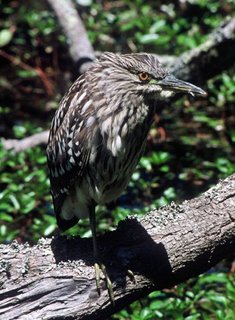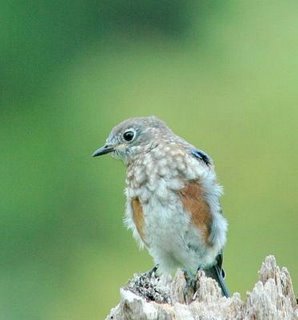Late summer is a time of change for birds. By now, the breeding season has ended for most species, and the young birds are out of the nest. Fledglings are rapidly maturing. Adults are molting their old feathers for fresh ones. Many species have already begun their journey south to their wintering grounds, such as the yellowlegs I covered last week. All this poses special challenges for birdwatchers. In some ways, this may be the most challenging times of the year.
Fledglings
Fledgling plumage may or may not be covered by field guides. Even the big Sibley Guide, for example, shows the fledgling plumage for American Robins, but it illustrates fledgling plumage less frequently for less common species. Fledgling robins themselves are sometimes a cause of confusion because of their spots. Adult robins do not have spots, but sport a solid orange breast. Fledglings, on the other hand, do have spotted breasts, much like other members of the thrush family. See below for an example.
Another example of juvenile plumage is the Black-crowned Night-Heron, pictured below. As with the robin, the juvenile plumage seems designed to make the night-heron less visible to predators while it is still maturing. Adult night-herons are much more conspicuous. Juvenile night-herons are not too difficult to identify, but the cryptic plumage could be confused with that of a juvenile Yellow-crowned Night-Heron or adult American Bittern.
The key to identifying juveniles, especially recent fledglings, is to remember that they are fledglings, and look for the species that they most resemble in structure. Bill length and shape, tail and wing size, and overall posture will be helpful here. Look for an answer among the common species first, before considering other, rarer possibilities.
Molt
A different kind of challenge is posed by molting birds. Some birds keep more or less the same plumage year-round. Even if they do, they need to molt each feather at least once per year to make up for normal wear and tear and retain the feathers' usefulness for insulation, flight, and waterproofing. Birds that retain the same plumage patterns throughout the year will simply look a little scruffier while they undergo their yearly molt. You might observe feathers missing; this is most obvious in the flight feathers of the wings and tail.
In many cases, birds have more than one plumage. Most birds with multiple plumages have one for winter (basic) and one for the breeding season (alternate). The differences between them may be quite stark. While the plumage for the breeding season is bright and colorful, for the winter these species take on a plainer appearance to make themselves less conspicuous.
Differences between basic and alternate plumage can be hard enough to remember, but this time of year adds another dimension to the puzzle. Birds molt their feathers gradually; they lose just enough to replace the whole set in a relatively short time, but keep enough to remain fully functional. Therefore, in late summer one will often encounter birds that are in between their alternate and basic plumages, such as the Scarlet Tanager pictured below.
With some birds, the molt may be so extreme that the bird will become bald for a short period of time. This seems to affect cardinals and blue jays most often, but other species will become bald occasionally. As with juveniles, the key is to focus on structural points and to consider the familiar possibilities first. Most of the time, a guess based on those criteria will be the correct one.
The following link is to a hunting website, but it has several waterfowl quizzes that might be of interest to you, including one on molting ducks. The photographs are worth a look.
None of the identification challenges presented here are insurmountable. Most birds that you see at this time of year can still be identified despite changing plumage and shifting populations. However, birding does require some more concentration and attention to detail now than at other times of year.
Crossposted at Blue Ridge Gazette.







